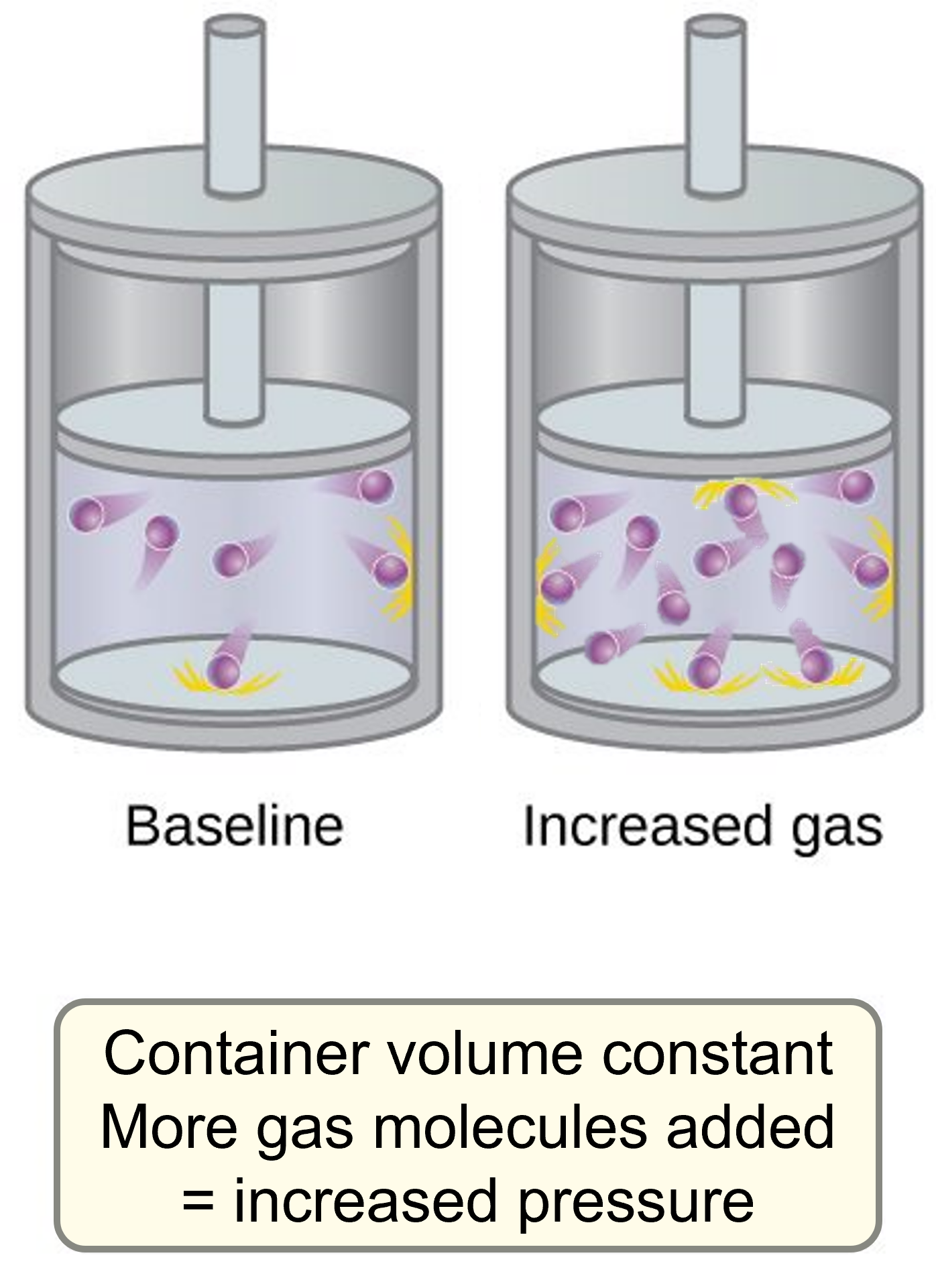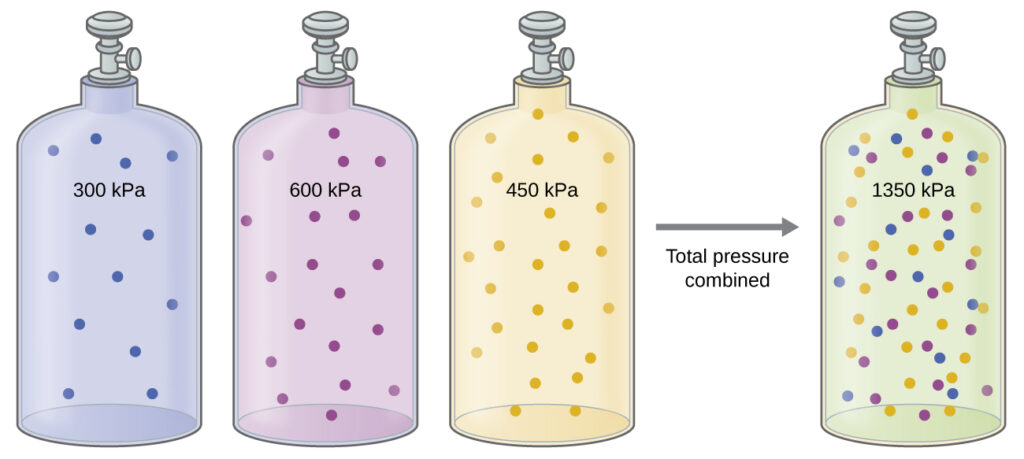When we add more gas (increasing the n or number of moles of gas in the container), there are now more particles of gas in the container, colliding with the walls. Although we have not changed the force applied with each collision, the number of collisions with the walls has increased. This causes the pressure in the container to increase.

Partial Pressures
This direct relation between number of moles and pressure also explains the concept of partial pressures of gases in a mixture: The total pressure of a mixture of ideal gases is equal to the sum of the partial pressures of the component gases: $$P_{Total}=P_A+P_B+P_C+…=\sum_{i}P_i$$
In the equation PTotal is the total pressure of a mixture of gases, PA is the partial pressure of gas A; PB is the partial pressure of gas B; PC is the partial pressure of gas C; and so on. This works because of our assumption #4 in the definition of kinetic molecular theory: the gas particles do not interact with each other, so it doesn’t matter if we have 1 mol of A and 1 mol of B; or 2 mol of A – all (ideal) gas particles behave in the same way, and only the total amount matters.

The partial pressure of gas A is related to the total pressure of the gas mixture via its mole fraction (X), a unit of concentration defined as the number of moles of a component of a solution divided by the total number of moles of all components:
$$P_A=X_A×P_{Total}\qquad where\qquad X_A=\frac{n_A}{n_{Total}}$$
where PA, XA, and nA are the partial pressure, mole fraction, and number of moles of gas A, respectively, and nTotal is the number of moles of all components in the mixture.
The Pressure of a Mixture of Gases
A 10.0-L vessel contains 2.50 ×10−3 mol of H2, 1.00 ×10−3 mol of He, and 3.00 ×10−4 mol of Ne at 35 °C.
(a) What are the partial pressures of each of the gases, in bar?
(b) What is the total pressure in bar?
Solution
The gases behave independently, so the partial pressure of each gas can be determined from the ideal gas equation, using $$P=\frac{nRT}{V}\\ P_{H_2}=\frac{(2.50×10^{−3}\;\require{enclose}\enclose{horizontalstrike}{mol})(0.08314510\; \enclose{horizontalstrike}{L}\;bar\; \enclose{horizontalstrike}{mol^{-1}K^{−1}})(308\; \enclose{horizontalstrike}{K})}{10.0\; \enclose{horizontalstrike} {L}}=6.40×10^{−3}\;bar\\ P_{He}= \frac{(1.00×10^{−3}\;\enclose{horizontalstrike}{mol})(0.08314510\; \enclose{horizontalstrike}{L}\;bar\; \enclose{horizontalstrike}{mol^{-1}K^{−1}})(308\; \enclose{horizontalstrike}{K})}{10.0\; \enclose{horizontalstrike} {L}}=2.56×10^{−3}\;bar\\P_{Ne}=\frac{(3.00×10^{−4}\;\enclose{horizontalstrike}{mol})(0.08314510\; \enclose{horizontalstrike}{L}\;bar\; \enclose{horizontalstrike}{mol^{-1}K^{−1}})(308\; \enclose{horizontalstrike}{K})}{10.0\; \enclose{horizontalstrike} {L}}=7.68×10^{−4}\;bar$$
The total pressure is given by the sum of the partial pressures:
$$P_T=P_{H_2}+P_{He}+P_{Ne}=(0.00640+0.00256+0.000768)\;bar=0.00972_{8}\; bar=\mathbf{9.73×10^{−3}\;bar}$$
Check Your Learning
A 5.73-L flask at 25 °C contains 0.0388 mol of N2, 0.147 mol of CO, and 0.0803 mol of H2. What is the total pressure in the flask in atmospheres?
Answer
1.137 atm
Here is another example of this concept, but dealing with mole fraction calculations.
The Pressure of a Mixture of Gases
A gas mixture used for anesthesia contains 2.83 mol oxygen, O2, and 8.41 mol nitrous oxide, N2O. The total pressure of the mixture is 192 kPa.
(a) What are the mole fractions of O2 and N2O?
(b) What are the partial pressures of O2 and N2O?
Solution
The mole fraction is given by $X_A=\frac{n_A}{n_{total}}$ and the partial pressure is $P_A = X_A \times P_{total}$ .
For O2,
$$X_{O_2}=\frac{n_{O_2}}{n_{total}}=\frac{2.83\;mol}{(2.83+8.41)\;mol}=0.252 \\ P_{O_2}=X_{O_2}\times P_{total}=0.252\times 192\;kPa=48.4\;kPa$$
For N2O,
$$X_{N_2O}=\frac{n_{N_2O}}{n_{total}}=\frac{8.41\;mol}{(2.83+8.41)\;mol}=0.748 \\ P_{N_2O}=X _{N_2O} \times P_{total}=0.748\times 192\;kPa=143.6\;kPa$$
Check Your Learning
What is the pressure (in bar) of a mixture of 0.200 g of H2, 1.00 g of N2, and 0.820 g of Ar in a container with a volume of 2.00 L at 20 °C?
Answer
1.89 bar